Today reader Elmer Fudd tells us about a sighting arrangement I have never heard of, or even thought of — using a peep sight with a scope. This should give you something to talk about this weekend!
If you’d like to write a guest post for this blog, please email me at blogger@pyramydair.com.
Take it away, Elmer.
Using a peep sight with a scope
by Elmer Fudd
This report covers:
- A peep with a scope
- Is cheek weld precise enough?
- The scope helps
- Scout scope
- Raise the peep
- Same for dot sight
- Proof
- Summary
- Helpful idea?
Most of the folks who reply here appear to be way more experienced and skilled with airguns than I am. Therefore, I have been a little reluctant to share this idea. But I figure it might help someone other than myself, so here it is.
A peep with a scope
My idea involves using a rear peep sight (diopter) in conjunction with a rifle scope. One of the advantages of using a peep sight is that it tends to facilitate precise and consistent positioning of the aiming eye (which is also important when using a rifle scope). We are taught about proper eye positioning using the cheek weld method.
Is cheek weld precise enough?
But just how precise is the cheek weld method? I can say for certain that for me (or, I suspect, most anyone else without a lot of experience) obtaining consistent and precise eye positioning is one of the more difficult aspects to master if you hope to shoot well. So, I figured, why not use the rear peep sight as an aid in aiming eye positioning when using a rifle scope? I tried this on a Crosman 3622 first.
The scope helps
We also get the benefit of the scope’s magnification and other aspects. The magnification can be especially helpful for those of us with older eyes. I have named this idea the peep scope concept (p-scope for short). It is an idea that came to me in a moment of frustration. I haven’t seen it elsewhere or copied it. [Editor — No kidding! I haven’t even thought of doing this!]
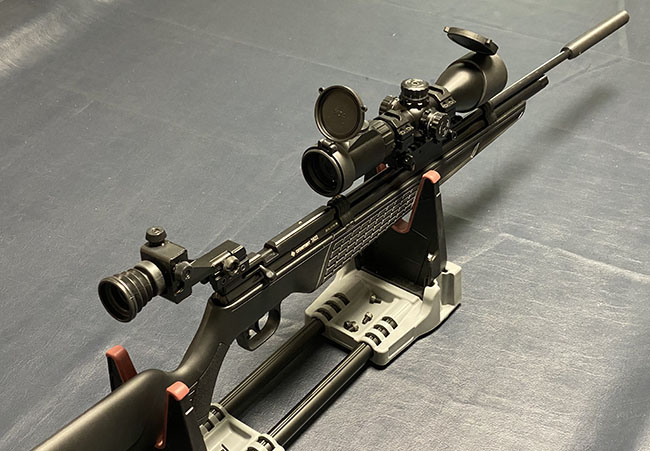
Crosman 3622 rifle with peep and scope.
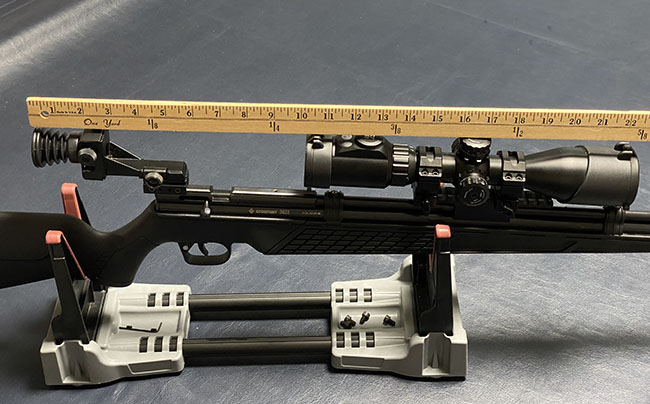
Crosman 3622 rifle with peep scope and ruler to show some distances.
Scout scope
I already had a UTG 2-7X44 scout scope with an extra long eye relief (9.5 to 11 inches) and a mount that clamps onto a barrel. I used a relatively inexpensive Daisy 5996 rear peep sight, but needed a riser mount to elevate it to approximately the same level as the scope. I mounted these sights on an inexpensive Crosman 3622 rifle with a steel breech.
Raise the peep
As you can see in the photographs above, the resulting height of the sights means that a riser for the comb of the stock would be best for obtaining a good cheek weld. The balance and center of gravity of this setup is also significantly changed by the addition of the sights. I think that this setup is okay for testing the concept while shooting from a bench. However, I plan to try the peep scope concept on a hopefully more suitable gun (Umarex Notos) very soon. I am expecting delivery soon of an adapter to enable me to mount the rear peep sight onto the Notos rail.
Same for dot sight
This same concept can also be used with a red dot sight (peep and dot concept, p-dot for short) in lieu of the scope. (I think that consistent aiming eye positioning is also important when using a red dot sight.) Here is a photo of my Crosman 362 rifle with that type of set up. I also use an anti-cant level with this set up. For my shooting experiences at least, using the level also makes a significant difference in consistent accuracy (aka: small target groups).
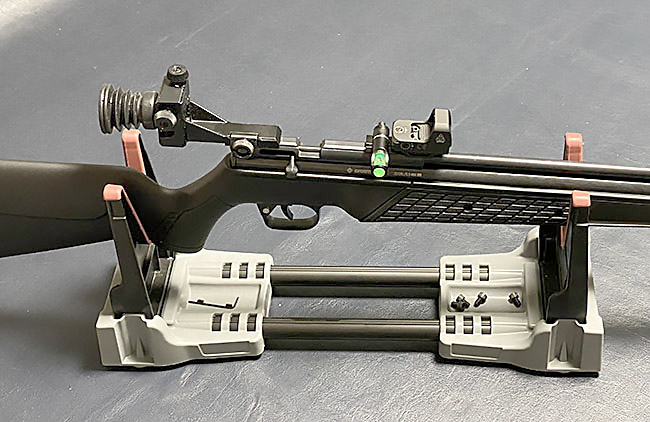
P-dot on 362 rifle shown from a different angle.
Proof
I can tell you that when I tried this idea it definitely improved my shooting results to a significant extent. Here are some photos of target groups that I shot with the Crosman 3622 p-scope and the Crosman 362 with the p-dot. The distance was 10 meters and the rifles were bag-rested front and rear.
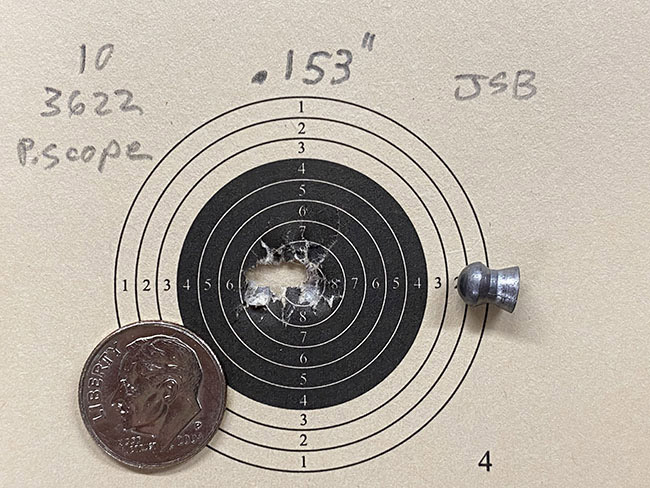
3622 with p-scope target results at ten meters. This is ten shots with the 14.35-grain JSB Jumbo Express.
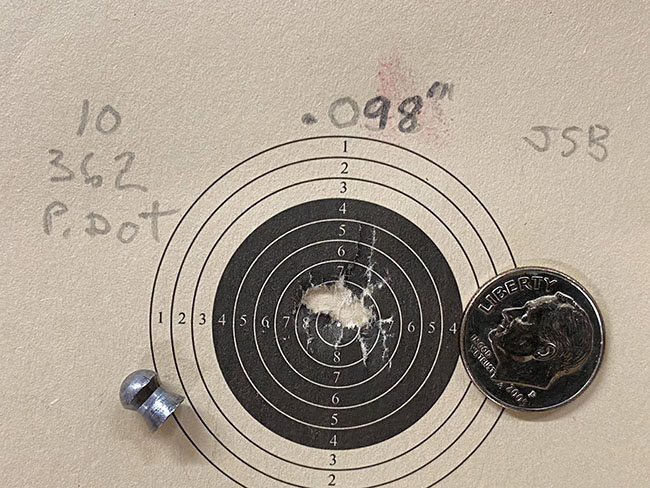
362 with p-dot target results at ten meters. Also ten shots with the .22-caliber JSB Jumbo Express.
Summary
Will this idea help anyone else? There is one way to find out.
I know there are a lot of very skilled shooters who participate here in this blog. Some of you might feel like this is more trouble than it is worth because you feel that it is not likely to improve your shooting results. However, you might never know for sure if you never give it a trial.
Also, this idea might be helpful in setting up a scoped rifle that has an adjustable stock, etc. and getting one’s posture and cheek weld perfected. If you do decide to give it a try, please let us know how it goes.

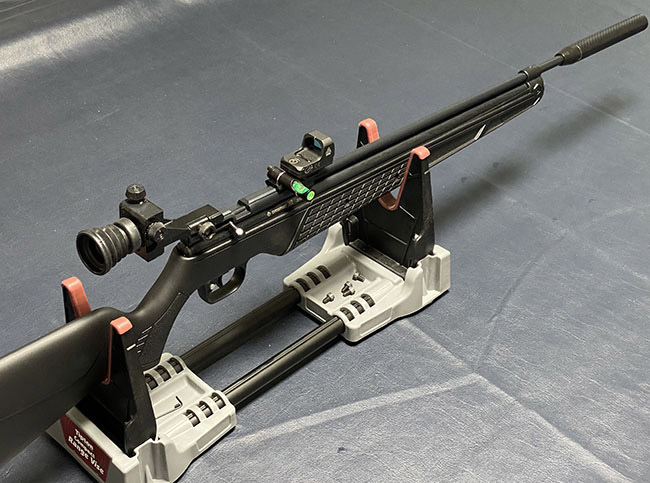
When I saw the photo, I thought, it isn’t April Fools’ day! What’s up?
The more I thought it over, the more sense it made, especially the dot sight.
Great work Elmer! Definitely thinking outside of the box.
The human eye always wants to center or “stack” objects, and it is pretty good ad doing so.
A 2moa dot and a peep sight gives a very fine aiming point that overlays the bull eye perfectly. And being able to adjust the intensity of the dot allows for it to be translucent so you can see the target through the image.
I will have to try this.
Ian
Thanks Ian, the excellent shooting results you have posted here in the past make me believe that you have the cheek weld method down pat. So if you get any improvements from trying this, then I think that most anyone else would be likely to benefit also. I suggest shooting a number of groups with and without the addition of the peep sight and averaging the sizes in order to compare the before and after results. Also, I think that mounting the dot sight out away from the peep sight (closer to the muzzle) should increase accuracy the way that a normal front aperture sight does on a traditional target rifle.
Hi guys first post but I’ve been reading the blogs for a while and was wondering do you guys have tips on how to get a good cheek weld? TIA
Darryld,
After seeing Elmer Fudd’s success with the 3622, I plan to work on a cheek rest report. It’s coming soon.
BB
Elmer,
Definitely outside of the box thinking. Surely forces you to make perfect alignment to be able to look through the scope and see the target. So at the end of the day do you take off the scope or the peep to use the 3622 on a daily basis?
Siraniko
Siraniko, good question! This is still relatively new to me. If I removed the scope, I would need to use a front sight in its place. I think that a traditional front aperture sight would be my choice for that. On the other hand, the scout scope works well (especially for longer distances) for those of us with older eyes. So, I think it would depend on what I was intending to use it for. For hunting purposes I would probably want to remove the peep sight (after I had gotten a good feel for the needed cheek weld). This would allow a larger field of view than what can be seen through the peep hole.
Definitely need to mount a scout scope on my 3662!
This is awesome! Your p-dot setup is very similar to my rear Williams peep and TruGlo front sight setup. I can easily see where either setup would be of great benefit to learn proper eye placement with cheek weld.
This is very good thinking “outside of the box” for solving an issue many have. I thank you for telling us about this.
Interesting, very interesting!
Thanks for sharing! Definitely food for thought!
Yeah, shooting small groups requires attention to details. I’m very fussy about getting a proper cheek weld and won’t hesitate to modify a stock to get a consistent hold/weld. For target work, I’m careful in adjusting the parallax for the range and all of my “long range” airguns (especially those with high mounted scopes) have bubble levels.
I have a couple of red-dot sights that I’m not too keen on using (because of alignment issues). Your p-dot idea might be just the thing to make me comfortable using them.
Hank
Hank, my experience indicated the most dramatic improvement with the p-dot. Your normally great attention to details in getting a consistent cheek weld and subsequent aiming eye position makes me most interested in any results you might get if you decide to give this idea a trial.
FM can see – no pun intended – trying this with a dot sight. One thing gleaned from this quite interesting post is that the 3622 can shoot; enablement brain lobe triggered!
FM,
Forget the 3622! You have several Maximus’ to experiment with. Are you planning on sending one of those Max’s to live at RRHFWA. Hint, hint, hint. 😉
Hate to hurt your feelings, friend – can’t see parting with “your” Max but if ever FM got to where he could not shoot it any more, you’d be first in line to get it back. FM sees the 3622 as cousin to the Maximus brothers, so might still acquire one down the road – seems it would be a fun plinker-pester-casual target shooter.
FM,
You will not hurt my feelings. Much.
I know it went to a good home.
This report is very interesting.
This aligns with my own experience that I haven’t really thought about in a while. I have a vintage Winchester 435 (a Diana 35) that came with nice open sights, but I was disappointed with the groups, so I added a vintage Diana peep sight. However, I noticed the rear sight was in the way. Before removing the rear sight, though, I cranked the knobs on the peep sight until I could see the front sight blade in the rear sight notch. I think this is essentially what you are doing with the p-scope and the p-dot…lining up your eye with the other sighting system. When I then cranked the rear sight down and out of the way, my peep sight was very close to where it needed to be.
I congratulate you on the groups achieved with the 362 at 10 meters. I don’t know of anyone getting those kinds of groups with the stock 362. So one thing the peep us doing for you is consistent eye (head) alignment and by extension, cheek weld.
The other thing the peep is doing is extending your sighting distance from the scope/dot all the way back to the peep. That increases precision the same way the increased distance between a front and rear sight on a rifle increases precision versus the relatively shorter distance between pistol sights.
What is remarkable and surprising is that you are seeing a difference between your p-scope setup versus a conventionally mounted scope.
Does the peep reduce your field of view at all?
How does the system work at 25 yards versus a conventionally mounted scope with shorter (3 to 4″l eye relief?
RG, yes your experience with the Winchester does basically reflect the alignment needed for this peep scope idea to work. When I was first getting the peep sight in reasonably close alignment with the scope I used a hand held laser pointer. I cut out two of the 10-meter targets, poked holes in the centers with an ice pick, and pasted one to the eye cup of the peep sight and the other one to the scope. Then when I could shine the laser through the hole in the first target, through the actual peep hole and it shone the brightest as it lit the hole in the second target (as would be shown in this photo if I could have held it steady while taking the photo with my phone), I felt that things were close to being in good alignment. Later, I discovered it was easier to just look through the peep hole and make sure the image in the scope was full and centered.
I also installed a Williams peep sight that is more of a sporting peep sight with a larger peep hole, to allow for greater distance between the eye and the peep hole, onto a Diana Two Forty. I did the opposite of your process though and got the peep sight sighted in, then used that to fine tune the alignment of the open rear sight. That way, I am thinking that if I ever remove the peep sight, the open sight should be in very good alignment.
“ What is remarkable and surprising is that you are seeing a difference between your p-scope setup versus a conventionally mounted scope.”
Stay tuned for part two for more evidence of the differences. And yes, the peep sight does definitely reduce the field of view. When I remove the soft rubber eye cup and move my eye closer to the actual peep hole I can see the entire image in the scope lens. But with the eye cup in place and my eye against the cup (but further from the peep hole) I can only see the center portion of the image in the scope lens.
I haven’t tried this at 25-yards yet. But I will try to do that when I get the chance.
Elmer,
WOW! You might have a breakthrough technique here.
For years I have helped my deteriorating vision lead my pellets to the target installing 1.5x magnifiers, called “eagle eyes” to my peep sight air rifles. There are two types, those which are installed in the aperture to magnify the front sight, and those which are installed at the front sight to magnify the target.
They are quite helpful, but what you have here is of a far greater, ahem, magnitude.
Well done!
Michael
Thanks Michael, I am glad to know that those magnifiers work for you. I have never had very good eyesight. And getting older kept making it worse. However, I recently underwent cataract surgery and it is making a big difference. The scope I am using goes from 2x to 7x if I remember correctly. And the crosshairs help with anti-cant efforts. It definitely helps me.
BB,
This is in reference to your remark concerning the definition of insanity.
I do indeed understand. The issue is I had started my journey with airguns with a Gamo and it is/was my personal desire to see just how far Gamo has come over the years.
Elmer Fudd,
BRAV ZULU hoist
That is something i have never seen before.
There is the co-witness: https://vortexoptics.com/blog/everything-you-ever-wanted-to-know-about-co-witnessing-part-two.html
And, there are also tip off (over) mounts that may solve your problem of permanently/temporarily getting your scope out of the way: https://vortexoptics.com/vortex-rzor-rt45-offset-mount.html?queryID=617721961d80afada974ad536aae4be2&objectID=6343&indexName=magento2_default_products
Or: https://www.opticsplanet.com/s/flip-to-side-mount
As examples that will help you keep thinking outside of the box!
Great Guest Blog!
shootski
Thanks Shootski, the first link to the co-witnessing article is good. I have however found that, at least when using my red dot sight and my eyesight, and while keeping the rifle and target perfectly still, moving my head around slightly actually does slightly affect where the red dot appears on the target. It could just be me and my eyesight. (I will test this again since my cataract surgery also addressed some astigmatism.) But, at this point in time, I have to wonder whether or not red dots are truly completely free of all parallax.
Elmer Fudd,
Great!
I hope you found Part One: https://vortexoptics.com/blog/everything-you-ever-wanted-to-know-about-co-witnessing-part-one.html
And this might help you and others also: https://vortexoptics.com/blog/whats-the-best-optic-for-your-ar-lets-talk-red-dots.html
Read AR as Air Rifle and not ArmaLite. AND, most certainly NOT assault rifle …lol!
Also: https://vortexoptics.com/blog/making-sense-of-magnified-optics-on-a-tactical-carbine-part-1.html
Great take on what magnification does for us…and DOES NOT!
https://vortexoptics.com/blog/making-sense-of-magnified-optics-on-a-tactical-carbine-part-2.html
hth,
shootski
Elmer Fudd,
There are still lots of folks debating how much parallax Red Dot sights have. I think even when they are properly sighted in there is some. It seems to have something to do with the lenses used and how much they cost (meaning better QA i guess?) along with the shooters eyeball shape.
For what actual use they are designed for they are gud enuff.
Your concept eliminates the problem by aligning everything as close as possible every time.
shootski
Thanks Shootski, that’s helpful. It appears that we agree. And also that if wasn’t just me and my red dot sight and my own imperfect eyesight.
Elmer
It is a treat to read a report or comment that is out of the box or at least new for me. I think you have hit a home run. I am sure your idea will help most of us because I have a scope type that limits the sight picture unless your eye is in the same place every time. I have quite a few of them. It’s the CP 6-20×50 sold here at a competitive price with stores. Not so good for hunting as it takes longer to get on target. The principle is the same as yours.
Thanks for sharing your idea.
Deck
Just got back from the yearly retina exam endured since the retinal detachment back in ’17; while testing visual acuity the tester had FM look thru a pinhole and, enlightening experience! Which should not have been surprising because FM should know by now pinholes gather and focus light – so what looked blurred to that less than perfect eye came into clear focus. Gotta start working with peep sights FM, see?!
FM, yes I had a similar experience when they were testing my eyesight before cataract surgery. The one I looked through had many holes (collimator device I think) Peep sights (at least the ones with the smaller peep holes) can work similarly to a light collimator device. See photo below.
Elmer,
Good job of looking at the problem with a new solution!
I’ve noticed that dot sights, for me, work great on a pistol but not so great on a rifle. You just informed me that my eye alignment hasn’t been consistent on a rifle but is much better at arms length with a pistol.
Time to retry the dot sight on the rifle!
Thanks for posting.
Bill
Elmer,
If it works for you, more power to ya….
Weird but effective, I would say.
Have a great weekend all,
-Yogi
I noticed this fella hanging out at the end of my driveway.
RR
Is it feral?
Deck
Aren’t they all?
RR
Good sounding nickname for her. She could guard against any Max escaping again should RR get his hands on another.
Deck
Another shall not escape if it should show up here.
Elmer,
You certainly have made the importance of cheek weld and eye alignment very clear for precise shooting and coming up with this workable solution is genius.
I believe DOT sighting was intended for quick target acquisition in close quarter combat, not so much for accuracy, but things evolve. A LASER DOT on the target itself leaves no room for doubt.
When DOT sights first came out my neighbor asked, “How do you know it’s on target when you move your head, it appears to move around?” I replied you need to keep the dot centered to be sure. I think a tubular DOT sight may be easier to keep centered but may interfere with an easy quick target acquisition a bit more. Your addition of the peep would really help there.
I have a VISM Gen II Carry Handle with a Laser and Micro Dot Combo out front that also has a fold up/down rear peep sight in alignment. May accomplish the same thing to some extent although it probably was intended to replace an AR15 rear sight for use if the LASER / DOT was removed.
And here is another example of a system that may help keep cheek and eye alignment. Did not know this existed until now.
What is that and where can we learn more about it?
I will echo RG. What is that?
Thanks Bob, I’ll have to think a little about keeping the dot centered. I think I understand why we would want to do that. However, when setting up the peep-dot on the Crosman 362 I had a little mismatch on the elevation. The peep sight is adjusted as high as it can go. And the dot needed to be lowered quite close to be bottom of the display and off to the right of center a bit in order for the pellet to be on target. I could try to find a short riser to raise the peep sight a little (the one I have raises it too high). And see if I can adjust the windage on the peep sight in order to center the dot horizontally. But the consistency of the eye position seems to be the most important factor. And using the level really tightened the groups up significantly. I would like to learn more about the sights available and typically used on AR15 rifles. A recent shooting has me curious to know more about the weapon used.
Sorry for a late reply. I only access the blog on my laptop and only check it a few times a day. Mostly at night.
Been busy, took my ex-wife in for a physical follow-up yesterday and after about an hour and a half the Doctor concluded she was in heart failure and wanted to have an ambulance take her to the hospital ASAP. She is still there. Multiple problems had developed.
That Dot Sight Assembly is called:
Tactical C-More Red Dot Reflex Sight, AR Rear Iron Sight Rifle Scope Hunting Optics, Integrated Picatinny Mount.
More info: TacticalGearTrade dot com or whatever else you can find. There are more pictures out there online.
It just seemed to do the same job.
It appears the fully adjustable AR rear sight would be capable of being adjusted to line up with the Dot sight all the way around and force you to line up with the Dot through it all the time. Otherwise, it would just be in the way of the Dot. Did not find exact details of its use.
Bob,
Your ex-wife is still in my prayers.
BB
BB.
Appreciate the prayers but to be honest she worked long and hard to achieve heart failure. I am indifferent.
She disregards Doctors advice and common sense, is over-indulgent, lazy, careless, overweight and self-centered. She has considered suicide to end the pain she lives with from overweight injuries. Broken back 2x, knees replaced, Pancreatitis, bad hips and shoulders, weakness with inability to walk without a cane or assistance and can’t drive. Lives in bed, smokes, has a can of soda open 24/7. Lives on TV dinners, chocolate, and candy.
I took her in to let my daughters have some sort of life without her. She can’t work. One just about disowned her and kicked her out of her home. She disregarded all my advice for years because, I’m just a know it all.
Some people just don’t care and only do what pleases them, regardless of the consequences.
I obviously did not know her well when I married her at 18.
This is cool…
https://x.com/ladbible/status/1818765254291284432
Fish
It is cool indeed. Reminds us of George Farr who showed up at Wimbledon in 1921 without a rifle or ammo and accomplished a feat so difficult they named a competition for him, the Farr Trophy.
Deck
Elmer Fudd, my ‘weekend’ is running late (hurricane prep), but I finally got a chance to sit down and read through your report; my vision is…not what it used to be; so this report is most intriguing and makes a lot of sense; thank you very much. 🙂
In Germany, we have the “Adlerauge” Kornoptik, which basically is a small scope that screws into the front sight of 10m match air rifles. It is used by elderly target shooters, and I’d be surprised if Mr. B.B. never heard of them?